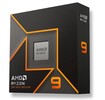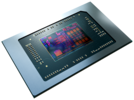AMD Ryzen 9 9950X vs AMD Ryzen 7 H 260 vs AMD Ryzen 7 8840HS
AMD Ryzen 9 9950X
► remove from comparison
The Ryzen 9 9950X is a very, very powerful desktop CPU of the Granite Ridge product family that features 16 Zen 5 cores (32 threads), PCIe 5 support and a basic iGPU. The Ryzen was launched in June 2024, with sales slated to start in August.
The 9950X shares some of the specifications with the mighty Zen 4-powered Ryzen 9 7950X, including (but not limited to) the 16 MB L2 cache, the 64 MB L3 cache, the 5.7 GHz top clock speed and the 170 W long-term TDP.
Architecture and Features
Just like Strix Point APUs, Granite Ridge processors make use of the new Zen 5 microarchitecture. However, there are no efficient cores here; all of 9950X's cores are full Zen 5 cores. Furthermore, Granite Ridge is a multi-die design with only the CPU cores produced using a fairly modern 4 nm TSMC process. Strix Point processors are a single-die design, from what we know.
According to AMD, Zen 5 delivers a 16% IPC improvement over Zen 4 thanks to branch prediction improvements and other refinements.
Elsewhere, the 9950X has an impressive 64 MB of L3 cache and 24 direct PCIe 5 lanes (3.93 GB/s throughput per lane) with up to 12 additional PCIe 4 lanes available depending on the motherboard. It supports DDR5 RAM as fast as 5,600 MT/s (up to 8,000 MT/s if overclocked).
The 9950X is unlocked for overclocking. Naturally, the AM5 socket CPU supports Windows 11, 64-bit Windows 10 as well as many Linux distros.
Performance
According to early July leaks, its multi-thread performance is about as good as that of the 24-core Core i9-14900K Intel CPU. We'll definitely update this section once we get our hands on a system powered by the 9950X.
Graphics
The Radeon 610M comes equipped with just 128 unified shaders running at up to 2,200 MHz. Its gaming performance is slated to be extremely low and only just sufficient for pre-2020 games in resolutions such as 1024x768.
Power consumption
The CPU cores are built with TSMC's N4P process for good, as of mid 2024, power efficiency. (Apple is the leader in this regard with the second-generation 3 nm process.)
The Ryzen 9's long-term TDP is 170 W. It'll probably consume up to 250 W when under heavy short-term loads. If overclocked, the power consumption figures will increase significantly.
AMD Ryzen 7 H 260
► remove from comparison
The AMD Ryzen 7 H 260 is a high-end notebook processor from the Hawk Point series with 8 cores and hyperthreading (SMT), which means it can process up to 16 threads simultaneously. At release, the CPU is only available in China and is technically practically identical to the older AMD Ryzen 7 8845HS or Ryzen 7 7840HS (slower AI engine).
The performance of the second-fastest model in the Hawk Point series should only be slightly behind the Ryzen 9 7940HS (+100 - 200 MHz clock, e.g. only 2% slower Turbo). As a result, the performance at 54W TDP should also be comparable to the AMD Ryzen 7 7745HX (also 8 Zen 4 cores, max 5.1 GHz, 55W, 32 MB L3) and thus clearly ahead of the old top model AMD Ryzen 9 6980HX resp. 6980HS (with lower TDP).
The chip integrates a modern RDNA 3-based graphics card (iGPU) called Radeon 780M with 12 CUs and up to 2.7GHz including AV1 video engine. Furthermore, a Xilinx FPGA-based XDNA AI accelerator is also integrated, which is now clocked higher. Hawk Point offers 2x USB 4 (40 Gbps), 20 PCIe 4.0 lanes and a dual-channel DDR5-5600 / LPDDR5x-7500 memory controller (with ECC support).
The Hawk Point series is a single chip (unlike the Dragon Range 7045HX series) and is manufactured at TSMC using the modern 4nm FinFET process.
AMD Ryzen 7 8840HS
► remove from comparison
The Ryzen 7 8840HS is a powerful processor (APU) of the Hawk Point family. This isn't an entirely new laptop chip; instead, it's a rebadged Ryzen 7 7840U with a slightly higher wattage as well as higher clock speeds on the Ryzen AI NPU. The 8840HS has eight Zen 4 cores running at 3.3 GHz to 5.1 GHz that are SMT-enabled for a total of 16 processing threads, while the great Radeon 780M is responsible for 3D processing and similar duties.
Architecture & Features
Hawk Point family chips are powered by the Zen 4 architecture, much like Phoenix and Dragon Range family chips are. That's not to say there is no difference between the three. With Hawk Point, AMD is betting big on generative AI; these processors are set to deliver an up to 40% increase in generative AI performance over 7040 series APUs, making apps like DaVinci Resolve and Adobe Photoshop more useful than ever before.
Unlike Zen 3, Zen 4 features AVX512 support and, thanks to a plethora of other improvements including larger caches/registers/buffers, is slated to bring a double-digit IPC improvement over the former.
Elsewhere, the 8840HS has 16 MB of L3 cache and support for super-fast DDR5-5600 and LPDDR5x-7500 RAM. The chip is compatible with USB 4 and therefore with Thunderbolt. It comes with 20 PCIe 4 lanes, giving NVMe SSDs up to 7.8 GB/s of throughput.
Systems built around this Ryzen 7 series APU are designed to run 64-bit Windows 11, 64-bit Windows 10, or Linux. Please note that this processor is not overclockable and neither is it user-replaceable. It gets soldered down for good instead (FP7, FP7r2, FP8 socket interfaces).
Performance
Since this is a 7840U in disguise that we are dealing with here, it is safe to expect the 8840HS to be about as fast as the Core i7-12650H, as far as multi-thread performance is concerned.
Your mileage may vary depending on how high the CPU power limits are, and how competent the cooling solution of your laptop is.
Graphics
The Radeon 780M has 12 CUs (768 shaders) purring away at up to 2,700 MHz. This is exactly the right iGPU for people looking for a bit more horsepower than what Intel's aging Xe options can provide. The Radeon will let you use up to 4 monitors with resolutions as high as SUHD 4320p and it will also HW-decode and HW-encode the most widely used video codecs (including AV1, HEVC and AVC) without breaking a sweat. In terms of gaming, the thing is good enough for 1080p and medium-to-low settings, as of late 2023.
Your mileage may vary depending on how high the CPU power limits are, how competent the cooling solution of your system is, how fast the RAM of your system is (there is no dedicated VRAM here).
Power consumption
This Ryzen 7 series chip has a long-term power limit (default TDP) of 28 W that laptop makers are free to tune to their liking, with values between 20 W and 30 W greenlighted by AMD. Either way, an active cooling solution is a must for any system powered by this chip.
The 8840HS is built with TSMC's 4 nm process for high, as of late 2023, energy efficiency.
| Model | AMD Ryzen 9 9950X | AMD Ryzen 7 H 260 | AMD Ryzen 7 8840HS | ||||||||||||||||||||||||||||||||||||||||||||||||||||||||||||||||||||||||||||||||||||||||||||||||||||||||||||||||||||||||||||||||||||||||
| Codename | Granite Ridge | Hawk Point-HS (Zen 4) | Hawk Point-HS (Zen 4) | ||||||||||||||||||||||||||||||||||||||||||||||||||||||||||||||||||||||||||||||||||||||||||||||||||||||||||||||||||||||||||||||||||||||||
| Series | AMD Granite Ridge (Zen 5, AM5) | AMD Hawk Point (Zen 4/4c) | AMD Hawk Point (Zen 4/4c) | ||||||||||||||||||||||||||||||||||||||||||||||||||||||||||||||||||||||||||||||||||||||||||||||||||||||||||||||||||||||||||||||||||||||||
| Series: Hawk Point (Zen 4/4c) Hawk Point-HS (Zen 4) |
|
|
| ||||||||||||||||||||||||||||||||||||||||||||||||||||||||||||||||||||||||||||||||||||||||||||||||||||||||||||||||||||||||||||||||||||||||
| Clock | 4300 - 5700 MHz | 3800 - 5100 MHz | 3300 - 5100 MHz | ||||||||||||||||||||||||||||||||||||||||||||||||||||||||||||||||||||||||||||||||||||||||||||||||||||||||||||||||||||||||||||||||||||||||
| L1 Cache | 1 MB | 512 KB | 512 KB | ||||||||||||||||||||||||||||||||||||||||||||||||||||||||||||||||||||||||||||||||||||||||||||||||||||||||||||||||||||||||||||||||||||||||
| L2 Cache | 16 MB | 8 MB | 8 MB | ||||||||||||||||||||||||||||||||||||||||||||||||||||||||||||||||||||||||||||||||||||||||||||||||||||||||||||||||||||||||||||||||||||||||
| L3 Cache | 64 MB | 16 MB | 16 MB | ||||||||||||||||||||||||||||||||||||||||||||||||||||||||||||||||||||||||||||||||||||||||||||||||||||||||||||||||||||||||||||||||||||||||
| Cores / Threads | 16 / 32 16 x 5.7 GHz AMD Zen 5 | 8 / 16 8 x 5.1 GHz AMD Zen 4 | 8 / 16 8 x 5.1 GHz AMD Zen 4 | ||||||||||||||||||||||||||||||||||||||||||||||||||||||||||||||||||||||||||||||||||||||||||||||||||||||||||||||||||||||||||||||||||||||||
| TDP | 170 Watt | 45 Watt | 28 Watt | ||||||||||||||||||||||||||||||||||||||||||||||||||||||||||||||||||||||||||||||||||||||||||||||||||||||||||||||||||||||||||||||||||||||||
| Technology | 4 nm & 6 nm | 4 nm | 4 nm | ||||||||||||||||||||||||||||||||||||||||||||||||||||||||||||||||||||||||||||||||||||||||||||||||||||||||||||||||||||||||||||||||||||||||
| max. Temp. | 95 °C | 100 °C | 100 °C | ||||||||||||||||||||||||||||||||||||||||||||||||||||||||||||||||||||||||||||||||||||||||||||||||||||||||||||||||||||||||||||||||||||||||
| Socket | AM5 | FP7/FP7r2/FP8 | FP7/FP7r2/FP8 | ||||||||||||||||||||||||||||||||||||||||||||||||||||||||||||||||||||||||||||||||||||||||||||||||||||||||||||||||||||||||||||||||||||||||
| Features | DDR5-5600 RAM, PCIe 5 + PCIe 4, SMT, AES, AVX, AVX2, AVX512, FMA3, MMX (+), SHA, SSE, SSE2, SSE3, SSSE3, SSE4.1, SSE4.2, SSE4A | DDR5-5600/LPDDR5x-7500 RAM, PCIe 4, Ryzen AI, MMX, SSE, SSE2, SSE3, SSSE3, SSE4A, SSE4.1, SSE4.2, AVX, AVX2, AVX-512, BMI2, ABM, FMA, ADX, SMEP, SMAP, SMT, CPB, AES-NI, RDRAND, RDSEED, SHA, SME | DDR5-5600/LPDDR5x-7500 RAM, PCIe 4, Ryzen AI, AES, AVX, AVX2, AVX512, FMA3, MMX (+), SHA, SSE, SSE2, SSE3, SSE4.1, SSE4.2, SSE4A, SSSE3 | ||||||||||||||||||||||||||||||||||||||||||||||||||||||||||||||||||||||||||||||||||||||||||||||||||||||||||||||||||||||||||||||||||||||||
| iGPU | AMD Radeon 610M ( - 2200 MHz) | AMD Radeon 780M ( - 2700 MHz) | AMD Radeon 780M ( - 2700 MHz) | ||||||||||||||||||||||||||||||||||||||||||||||||||||||||||||||||||||||||||||||||||||||||||||||||||||||||||||||||||||||||||||||||||||||||
| Architecture | x86 | x86 | x86 | ||||||||||||||||||||||||||||||||||||||||||||||||||||||||||||||||||||||||||||||||||||||||||||||||||||||||||||||||||||||||||||||||||||||||
| Announced | |||||||||||||||||||||||||||||||||||||||||||||||||||||||||||||||||||||||||||||||||||||||||||||||||||||||||||||||||||||||||||||||||||||||||||
| Manufacturer | www.amd.com | www.amd.com | www.amd.com | ||||||||||||||||||||||||||||||||||||||||||||||||||||||||||||||||||||||||||||||||||||||||||||||||||||||||||||||||||||||||||||||||||||||||
| Die Size | 178 mm2 | 178 mm2 |
Benchmarks
Average Benchmarks AMD Ryzen 9 9950X → 0% n=0
Average Benchmarks AMD Ryzen 7 8840HS → 0% n=0
* Smaller numbers mean a higher performance
1 This benchmark is not used for the average calculation












